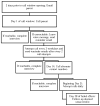Predictors of successful telephone follow-up in a multicenter study of infants with severe bronchiolitis
- PMID: 28645568
- PMCID: PMC5550350
- DOI: 10.1016/j.annepidem.2017.05.018
Predictors of successful telephone follow-up in a multicenter study of infants with severe bronchiolitis
Abstract
Purpose: To identify the characteristics that predict successful telephone follow-up with parents of infants with severe bronchiolitis.
Methods: We analyzed data from a 17-center, prospective cohort study of infants (age <1 year) hospitalized with bronchiolitis during three consecutive fall/winter seasons. Participant contact information and clinical data were collected during the index hospitalization. Parents were called at 6-month intervals (based on the child's age) after discharge to assess respiratory problems. The primary outcome was age 12-month telephone interview status. Participants were classified as unreachable after 28 days of unsuccessful attempts.
Results: 798 of 916 children (87%) completed the age 12-month telephone interview. In unadjusted analyses, factors associated with successful follow-up included: private health insurance, annual household income $60,000 or more, and residing in the Northeast, Midwest, or West. Follow-up was less common among non-Hispanic blacks, Hispanics, and households with 3 or more children. In multivariable analyses, follow-up was more likely among parents of females, and, compared with the South, in the Northeast and Midwest (all P < .05). Compared with non-Hispanic whites, non-Hispanic blacks and Hispanics remained less likely to complete the interview as did households with 3 or more children (all P < .05).
Conclusion: Sociodemographic and geographic factors predict successful telephone follow-up, even among parents of infants with severe illness.
Keywords: Bronchiolitis; Cohort studies; Follow-up; Infant; Race; Socioeconomic status.
Copyright © 2017 Elsevier Inc. All rights reserved.
Conflict of interest statement
Figures
Similar articles
-
The role of race and ethnicity in the State Children's Health Insurance Program (SCHIP) in four states: are there baseline disparities, and what do they mean for SCHIP?Pediatrics. 2003 Dec;112(6 Pt 2):e521. Pediatrics. 2003. PMID: 14654674
-
Feeding Infants and Toddlers Study: characteristics and usual nutrient intake of Hispanic and non-Hispanic infants and toddlers.J Am Diet Assoc. 2006 Jan;106(1 Suppl 1):S84-95. doi: 10.1016/j.jada.2005.09.040. J Am Diet Assoc. 2006. PMID: 16376633
-
Self-rated health and race among Hispanic and non-Hispanic adults.J Immigr Minor Health. 2008 Jun;10(3):229-38. doi: 10.1007/s10903-007-9074-6. J Immigr Minor Health. 2008. PMID: 17653864
-
Racial/ethnic differences in the presentation and management of severe bronchiolitis.J Hosp Med. 2014 Sep;9(9):565-72. doi: 10.1002/jhm.2223. Epub 2014 Jun 10. J Hosp Med. 2014. PMID: 24913444
-
US birth weight/gestational age-specific neonatal mortality: 1995-1997 rates for whites, hispanics, and blacks.Pediatrics. 2003 Jan;111(1):e61-6. doi: 10.1542/peds.111.1.e61. Pediatrics. 2003. PMID: 12509596 Free PMC article.
Cited by
-
Incentive delivery timing and follow-up survey completion in a prospective cohort study of injured children: a randomized experiment comparing prepaid and postpaid incentives.BMC Med Res Methodol. 2021 Oct 27;21(1):233. doi: 10.1186/s12874-021-01421-8. BMC Med Res Methodol. 2021. PMID: 34706653 Free PMC article. Clinical Trial.
References
-
- Ashery RS, McAuliffe WE. Implementation issues and techniques in randomized controlled trials of outpatient psychosocial treatments for drug abusers: Recruitment of subjects. Am J Drug Alcohol Abuse. 1992;18(3):305–329. - PubMed
-
- Hunninghake DB, Darby CA, Probstfield JL. Recruitment experience in clinical trials: literature summary and annotated bibliography. Controlled Clin Trials. 1987;8:6S–30S. - PubMed
-
- Office of Extramural Research NIH. 2001 http://grants.nih.gov/grants/funding/women_min/guidelines_amended_10_200....
-
- Hunt JR, White E. Retaining and tracking cohort study members. Epidemiol Rev. 1998;20(1):57–70. - PubMed
MeSH terms
Grants and funding
LinkOut - more resources
Full Text Sources
Other Literature Sources


